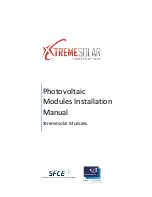
6
7
INSTALLATION AND OPERATION MANUAL SOLAR MODULES GENERATION 4 (G4) – HANWHA Q CELLS GMBH – EN
INSTALLATION AND OPERATION MANUAL SOLAR MODULES GENERATION 4 (G4) – HANWHA Q CELLS GMBH – EN
Installation Site
Please note the following guidelines that apply to the
installation site:
•
The modules have been tested according to IEC 61215
for operation in a temperate climate.
•
Solar modules are not explosion-proof and are not suitable
for use in explosive environments.
Ä
Do not operate solar modules near highly flammable gas
and vapors (e.g. gas tanks, gas stations).
Ä
Do not install modules in enclosed space.
Ä
Do not install modules in locations where they may be
submerged in water for lengthy periods (e.g. floodplains).
Ä
Do not use modules as a substitute for the normal
roofing (e.g. modules are not rainproof).
Ä
Do not install modules in close proximity to air conditioning
systems
The solar modules are designed for the following applica-
tions:
•
Operating temperatures from –40 °C to +85 °C
(–
40 °F to +185 °F).
•
Wind loads up to max. 4,000 Pa and snow loads up
to max. 5,400 Pa (Test-load in accordance with IEC
61215, see chapter 2.3 mounting options).
•
Installation using a mounting frame for solar modules.
Prevention of Shadowing Effects
Optimal solar irradiation leads to maximum energy output:
Ä
For this reason, install the modules so that they face
the sun.
Ä
Avoid shadowing (due to objects such as buildings,
chimneys or trees).
Ä
Avoid partial shading (for example through overhead
lines, dirt, snow).
Mounting Frame Requirements
The Modules shall be installed and operated on mounting
frames that comply with any applicable laws and stipula-
tions as well as with the following:
•
Conform to the necessary structural requirements.
•
Compliant with local snow and wind loads.
•
Properly fastened to the ground, the roof, or the façade.
•
Forces acting on the module are relayed to the mounting
substructure.
•
Ensures sufficient rear ventilation of the module.
•
Guarantees long-term stability.
•
Avoid the usage of different metals to prevent contact
corrosions.
•
Allows for stress-free expansion and contraction due to
temperature fluctuations.
Ä
Ensure that no mechanical stresses (e.g., caused by vibrations,
twisting, or expansion) are generated on the module.
Ä
Ensure that the clamps and the mounting frame are
compatible.
Clamp System Requirements
Use customary clamps that satisfy the following require-
ments:
•
Clamp width:
≥
40 mm.
•
Clamp height compliant with a 32 mm frame height.
•
Clamp depth: 7–12 mm.
•
Clamps are not in contact with the front glass.
•
Clamps do not deform the frame.
•
Clamps that satisfy the structural requirements of the
installation site.
•
Long-term stable clamps that securely affix the module
to the mounting frame.
Module Orientation Requirements
•
Vertical or horizontal installation is permitted.
Ä
Ensure that rain and melting snow can run off freely.
No water accumulation.
Ä
Ensure that the drainage holes in the frame are not
covered. No sealing.
Ä
Maintain the permissible angle of
inclination.
•
Minimum angle of inclination: 3°
•
Maximum angle of inclination: 75°
Ä
Follow the directions for installation
angles < 5° (“Grounding”, p. 19)
75°
3°
2.2 Requirements
2 PLANNING
Fig. 3:
Installation options for crystalline Q CELLS modules. All dimensions are given in mm. Also observe the
allowed static loads and clamping range as specified on the following page.
The illustrated installation options apply for both horizontal and vertical module orientation.
Module
Clamp
Subconstruction
Mounting profile
2.3 Mounting options
2 PLANNING
TYPE OF
INSTALLATION
MODULE
POINT MOUNTING SYSTEM
LINEAR MOUNTING SYSTEM
INSTALLATION
WITH CLAMPS
Q.PRO-G4.X
Q.PRO EC-G4.X
Q.PRO BFR-G4.X
Q.PLUS BFR-G4.X
HYBRID CLAMPING
Q.PRO-G4.X
Q.PRO EC-G4.X
Q.PRO BFR-G4.X
Q.PLUS BFR-G4.X
INSTALLATION
ON MOUNTING
POINTS
Q.PRO-G4.X*
Q.PRO EC-G4.X
Q.PRO BFR-G4.X
Q.PLUS BFR-G4.X
INSTALLATION
WITH INSERTION
PROFILES
Q.PRO-G4.X
Q.PRO EC-G4.X
Q.PRO BFR-G4.X
Q.PLUS BFR-G4.X
NOT PERMITTED
*Note: please check Q.PRO-G4 module version for fastening point distance (long edge with 980 mm or 1170 mm possible)
CL3
CL4
250 - 450
150 - 350
0 - 300
0 - 300
CL3
CL4
CL4
0 - 200
CL1
250 - 450
150 - 350
CL1
345
274
FB2
EN
4 × Fastening
points
4 × Fastening
points
FB2
EN
345
4 x Fastening
points
274
4 x Fastening
points
FB1
FB1
300 - 400
0 - 100
CL5
0 - 100
CL2
0 - 100
CL2
IP1
IP2
IP1
IP2






























